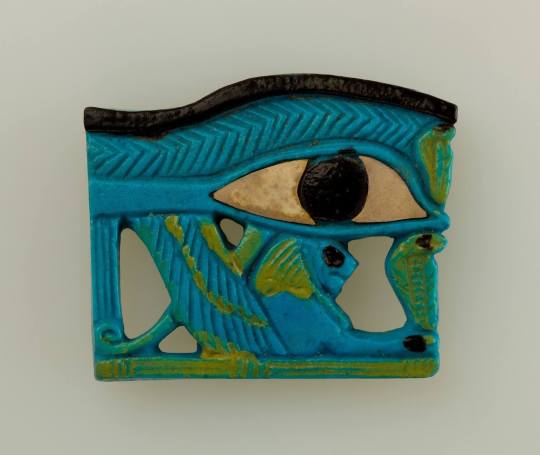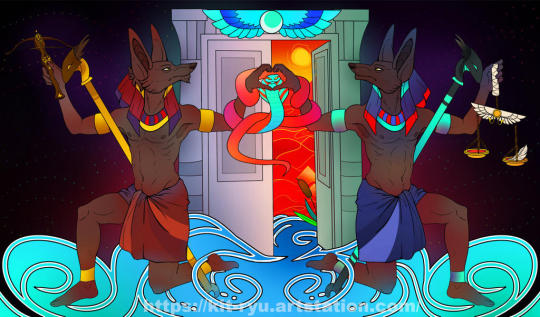#Wadjet
Explore tagged Tumblr posts
Text


more stuff with my Pokémon Mystery Dungeon OCs!
this is the one that stores their items
#umm it opens however okay its a scarmophagus#myart#pmd ocs#pokémon#sableye#noibat#cofagrigus#quil#lye#wadjet
191 notes
·
View notes
Text

Glazed faience wadjet eye amulet
The Eye of Horus is an ancient Egyptian symbol that represents protection, health, and restoration. It’s often associated with the god Horus, who was depicted as a falcon or a man with the head of a falcon.
According to Egyptian mythology, Horus lost his eye in a battle with his uncle Seth, but it was later healed by the god Thoth, symbolizing the restoration of his power. This healing process became the symbol of the Eye of Horus.
Each part of the eye also had a specific meaning and value in ancient Egyptian measurements, relating to fractions of a whole, symbolizing wholeness and balance. The Eye of Horus was commonly worn as an amulet for protection, and it was believed to ward off evil and bring good fortune.
Late Period, 26th Dynasty, ca. 664-525 BC. Now in the British Museum. EA29222
Read more
87 notes
·
View notes
Text

String of Wadjet amulets, 1981BC-1640BC, Egypt.
677 notes
·
View notes
Text

I have nothing to show but Ra
43 notes
·
View notes
Text
Kemetic Diety Jar
This is just some basic items that each deity likes. The intention behind this is to in a deity jar (which can be worn as a necklace), as opposed to these being offerings.
These items can be used as something to put on an alter, but from the research I did, there are other things you would offer to them.










#my post#visiongodess deity work#wicca#pagan wicca#witchy#wiccan#kemetic#egyptian mythology#egyptian paganism#egyptian deities#egyptian gods#egyptian pantheon#bastet#anubis#anubis deity#bastet deity#horus#sobek#ra#Set#hathor#wadjet
52 notes
·
View notes
Note
What's your opinion on the petpet Wadjet?

Wadjets are mostly just a snake, but they have a distinct Lost Desert flair to them. Outside of the eye liner, their bodies have a distinct ringed look to them with thick black accent lines, which fits the land without being too over-the-top about it and makes them very pretty. It's even said they can be mistaken for necklaces when around a Neopet's neck, which I think is cute and works well with their design.

I will say though that their art is very dated—they were released in 2001 and never redrawn, and it shows (especially in the larger How to Draw art above). Not only do they have very light shading that's barely noticeable, but the lineart's a bit too thin and looks almost wobbly in a few spots. The L pose also feels a little unnatural, like their body should curl down at the bend and then go up. This TCG art looks pretty good as a clean-up example, though I do think the gold rings should curve around the upper body more:

I'd love to see a redraw for these guys to clean them up, but given how low that is on TNT's concerns list I wouldn't expect to see it anytime soon.
Favorite Colours:

Rainbow: There's very little to talk about in terms of colours for these guys because they're all pretty generic, but I like the rainbow one quite a bit. I think it's neat how the rings divide each color change and it keeps the gold accents separate, which some other colours fail to do.

Ghost: I like how this one takes all the yellow accents and makes them red instead of just making the rings the same color as the body; it really makes it pop and balances the colors nicely.

Yellow: There's nothing really special about this one, but given that the Wadjet already has gold accents by default I think it looks really pretty with a yellow base and deeper golden yellow rings.
Least Favorite Colour:

Royal: You probably could argue that this isn't as bad as some of the bland Wadjet colours, but I don't know, this one just doesn't do it for me. Even if you can put aside how they just kept the body green instead of choosing something to match the palette, the robe covers up all the interesting body markings. There's also something weird about putting European king clothing on a creature from the Neopets equivalent of ancient Egypt.
32 notes
·
View notes
Text

29 notes
·
View notes
Text

✨ Ouadjet ✨ Pour une future bannière de stand...
#artists on tumblr#french artist#clip studio paint#digital artist#ancient egypt#egyptian gods#ouadjet#wadjet#snake
20 notes
·
View notes
Text
Statuette of Wadjet, copper alloy
circa 1070–664 B.C.
Metropolitan Museum of Art, New York



#wadjet#ancient egypt#ancient egyptian mythology#egyptian gods#egyptian mythology#egyptology#statuette#kemetic
23 notes
·
View notes
Text

Wadjet-Bastet, with a lioness head, the solar disk, and the cobra that represents Wadjet.
108 notes
·
View notes
Photo

A copper alloy statuette of Wadjet.
When: Third Intermediate Period
Where: Metropolitan Museum of Art, New York
35 notes
·
View notes
Text

Wadjet Eye Amulet
Third Intermediate Period, ca. 1070-664 BC. Made of Egyptian faience and aragonite. Now in the Metropolitan Museum of Art. 26.7.1032
Wadjet eye amulets were among the most popular amulets of ancient Egypt. The wadjet eye represents the healed eye of the god Horus and embodies healing power as well as regeneration and protection in general.
This faience eye here is an intriguing combination of the regular wadjet eye with a wing, two uraei, and a lion. This combination alludes to various ancient Egyptian stories that involve the eye of the sun-god Re.
Read more
298 notes
·
View notes
Text
Wadjet
𓆘 𓇅𓏏𓆗 𓇆𓏏𓆇𓆗 𓇅𓏏𓆘
𓇅𓇌𓏏 𓇆𓇌𓏏𓆗 𓇅𓏏𓇌 𓇅𓇌𓏏𓉐
𓇆𓇌𓏏𓐎𓆗 𓇅𓏤 𓇅𓏏𓆇 𓇅𓇌𓏏𓆗
𓍯𓄿𓏏𓆓 𓏸𓏸𓏸𓇅𓏏𓆘 𓇆𓇌𓏏𓆇𓆙
Epithets
The mother of all the gods
Great of Magic
Mistress of Earth
The Devouring Flame
Who burns the enemy at the bow of the barque of Re
She who gives light
She who glows in the darkness
Areas of Worships
Wadjet was the tutelary goddess of Lower Egypt but her cult center was in Pe and Dep. her shrine was called the per-nu or the ‘House of Flame.’
Offerings
Cobra statues or imagery of the uraeus.
You can also offer her fire- whether this is imagery, candles, or bonfires.
You can offer her papyrus, plants that grow in marshes (like cattail), or fresh greens.
Incense, candles, essential oils, or perfumes that smell of Myrrh, dragonsblood, fresh scents, grass, earthy scents
Jewelry, lapis, turquoise, or faience
Information
Wadjet’s name means ‘the fresh one,’ ‘the green one,’ or ‘she of the papyrus.’ Pinch believes this may refer to her embodiment of the constantly renewed vegetation of the marshes. The marshes themselves play a big role in Wadjet’s connection to Horus, though, as this became the place where Isis left her son to find her husband’s corpse. Wadjet and Nekhbet become the wet nurse to Herusaaset, protecting and shielding his body from any evil that may threaten him.
Wadjet was the tutelary goddess of Lower Egypt; whereas Nekhbet was the tutelary goddess of Upper Egypt- together they were know as the ‘two ladies.’ You can see both of them on the Double Crown of Egypt, or the Pschent crown, where they symbolized the unification of the two lands. Pinch suggests that perhaps they were warring opposities, in the same way that Sutekh and Horus are, but no surviving texts survive to back this up.
Wadjet, herself, is the emboidment of the ureaus on the royal headdress. She’s a protective deity of kingship and would spit fire/venom at the enemies of the pharaoh. She can be seen protecting both Re and Wesir, where she protected Re’s solar barque and the corpse of Asar. Her protecting the corpse of Wesir might connect her to being a guardian of the deceased king.
#wadjet#information on egyptian gods#wadjet goddess#egyptian goddess#kemetic#kemetic paganism#kemetism#ancient egypt#pagan#paganism#ancient kemet#deity worship#deity work#kemetic pagan#information#eye of re#kemetic epithets#kemetic religion#kemeticism#pagan religions#eclectic pagan#paganblr#goddesses#protection goddesses
14 notes
·
View notes
Text

Horus may be deflecting his Pharoh bloodline responsibilities a bit.
Comics aren't my forte, but I'm trying lol
33 notes
·
View notes
Text
Wadjet info for worship
Here is some information I found on Wadjet. If I missed anything or got something wrong, please feel free to correct me.









#my post#visiongodess deity work#kemetic paganism#kemetic#wadjet#Wadjet goddess#deity#kemetic deity#egyptian mythology#egyptian gods#egyptian deities#egyptian paganism#serpent goddess#goddess worship#deity worship
12 notes
·
View notes
Text

Dua Yinepu, Wepwawet, and Wadjet
(Old art, I don't think my artstation page works anymore. You can find this and more @ deviantart.com/kitryu)
98 notes
·
View notes